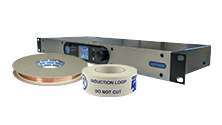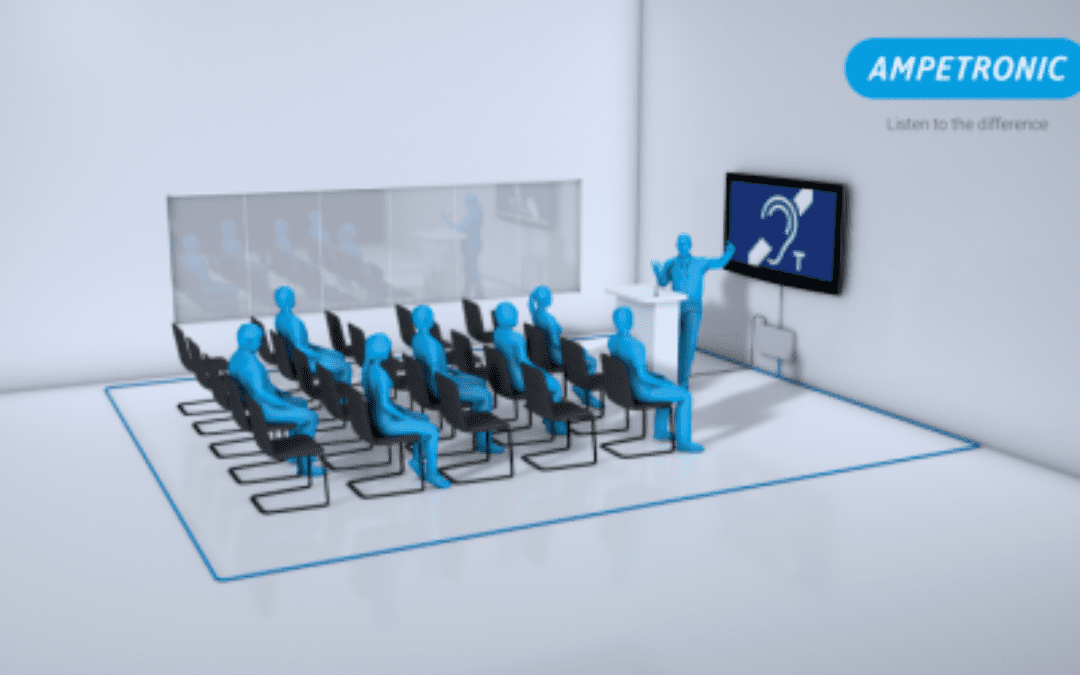‘Invisible’ No Longer
Staying current on assistive-listening legislation and hearing-loop installation standards.
By Steve Thunder
As technology has allowed assistive-listening devices (ALDs) to be more accessible to people and companies, requests for worldwide compliance have become the norm. That seems like a commonsense response, considering 50 percent of older adults alone experience some degree of hearing loss. Current legislation across the country, most notably in New York NY and Minnesota, continue to support the assistive-listening movement. It is important to stay updated on the new and evolving laws to ensure projects are compliant with local, state and federal requirements.
Why Assistive Listening?
One out of five American adults experience a world with varying degrees of silence due to hearing loss, which is often referred to as the “invisible disability.” Hearing loss can be incredibly isolating…but it doesn’t have to be. ALDs help people listen in difficult environments. They’re also mandated by the Americans with Disabilities Act (ADA).There are three main types of assistive-listening systems: radio frequency (RF), infrared (IR) and hearing loop. Hearing-loop technology remains at the forefront as a preferred assistive listening technology, due to unique advantages to the hearing impaired.
Existing Law
In 2010, new standards for the ADA became law, and they took full effect on March 15, 2012; they mandate ALDs for all new construction or renovations.
The following are highlights of the changes specifically for assistive-listening systems:
1. An assistive-listening system shall be provided in assembly areas where audible communication is integral to the space. That means that any space where people gather (a boardroom, banquet hall, classroom, movie theater, etc.) is required to have an assistive-listening system. Assistive listening must cover the entire space of the venue, not just one area.
2. Assistive listening is required where there is amplified sound. If there is a microphone and/or speakers, a system is needed. In addition, courtrooms must have assistive-listening systems, even without amplified sound.
3. In the original standards, the number of ALDs was four percent of seating capacity. With the new standards, the number of receivers has been scaled to match the total
occupancy of the venue, including portable seating.
4. Receiver Hearing-Aid Compatibility: A percentage of receivers is required to be 4. hearing-aid compatible and interface with telecoils in hearing aids. This is accommodated via neck-loop technology with RF or IR assistive-listening systems.
New Laws
New York City passed legislation this past March that requires:
1. All new construction or reconstruction projects with a baseline cost of more than $950,000 to install a hearing-loop system in at least one assembly area.
2. Hearing-loop-specific signage, meaning the “T” in the lower corner, to be used. Additionally, the mayor’s office posts on its website which assistive-listening system (IR, RF or hearing loop) is available in any facility that the city owns or operates.
Although the law will certainly increase hearing accessibility with hearing loops, there are some exemptions available, when necessary. For example, if a facility is not owned by the city, the city contributes less than half of the estimated cost and the city provides less than $1 million, then the project is exempt. A simpler exemption is if the loop system cost exceeds five percent of the baseline construction cost. The mayor may grant exemptions for projects, as well. Exemptions are only for the specific installation of a hearing loop; there is no exemption from the federal law with respect to the ADA. So, the installation of an assistive-listening system with the proper number of receivers is still required in all assembly areas. Look for the law to take effect on
applications filed on or after January 1, 2018.
Minnesota passed legislation this past May that included acoustics, in addition to hearing-loop requirements. Specifically, all gathering spaces that are for 15 or more people and that have a PA system must include a hearing-loop system, and they must meet American National Standards Institute (ANSI) guidelines for maximum background September 2017 Sound & Communications October 2017 Sound & Communications 41 noise levels and reverberation times. A commissioner or agency head is allowed to issue exceptions for the requirements, but he or she must first consult with the Commission of Deaf, Deafblind and Hard-of-Hearing Minnesotans. A report must also be issued every other year with information about the exemptions. The law is already in effect, and it applies to any project funded after January 1 of this year, but with an exemption for projects that completed their schematic design before May 30 of this year.
Rick Korinek of Midwest Hearing Loops said, “We are excited about the law. During a hearing on the bill in which we provided testimony, several legislators admitted to having hearing loss, and that they benefited by using hearing aids. They appreciated how a loop would help them and others in difficult-to-hear environments. In an acknowledgement of the prevalence of hearing loss, numerous committee members stated they had family members or acquaintances with hearing challenges. This recognition by the committee resulted in support for hearing-loop technology and the bill.”
Updated ANSI Standards
ANSI recently updated its standard to require that hearing-loop installations meet the international hearing-loop performance standard (IEC 60118-4). That updated ANSI standard will presumably be adopted by building codes, thus making it a legal requirement that an installed hearing loop meet the IEC performance standard. A major bill is expected
to become law, as it has already passed the Senate on a 96-to-1 vote. That bill will pave the way for hearing aids to be sold ‘over the counter,’ without a prescription.
Developing Law
A major bill is expected to become law, as it has already passed the Senate on a 96-to-1 vote. That bill will pave the way for hearing aids to be sold “over the counter,” without a prescription. That is expected to reduce dramatically the cost of hearing aids, which currently average about $2,400 each. Although there are still many details for the FDA to work out, most experts anticipate wareness of hearing loss will increase significantly as it becomes easier for large chain stores to sell cheaper OTC hearing aids, and as advertisements become more common. With that increased attention to hearing loss, it’s only logical also to expect increased awareness of assistive listening in public spaces.
Hearing-Loop Installation Standards
Current legislation is already making an impact by raising awareness of the effectiveness of hearing loops and the need for assistive listening.
Equally important as understanding the letter of the law is keeping current on installation standards, especially when installing a hearing-loop system. A loop system that is poorly designed, specified or installed can lead to higher total costs, more hassle, and a system that isn’t truly effective for end users or compliant with the law.
Hearing loops, unlike other, more traditional assistive-listening technologies, require a higher level of knowledge of testing and design factors, such as metal loss and spill control. Those aspects are all important to install a system that meets the IEC hearing loop standard, which, as noted above, might soon be a legal requirement in many more areas.
Although “too much metal” is rarely a reason not to install a loop system, not properly accounting for that metal can lead to a system that sounds muffled, with dramatic swings in loudness throughout the seating area. Experienced hearing loop engineers can design systems that work perfectly in the presence of vast amounts of steel; think about, for example, the hearing loops installed on the USS Intrepid in New York City.
System designs that don’t account for loop signal overspill are another example of poor design. Even when there is little metal in the building, designing a system that confines the loop signal
to a single area can be very important; think about, for example, adjacent classrooms or performance areas where electric guitars might be used. It’s possible to achieve a 40dB drop in loop
signal level in as few as five feet from the loop wires; that, however, requires sophisticated design tools, a knowledgeable design engineer and an experienced installer. It’s critical that the
system specifier understand the level of spill control needed for the space; specific spill-control levels are not part of any law or standard, but they’re critical to providing a useful system without
crosstalk or feedback issues.
It’s important to use drivers that are specifically designed to drive hearing loops. Those drivers will be able to handle the range of loads for hearing loops properly, while they continue to deliver enough high-frequency power to ensure clear sound, with no distortion.
The drivers must remain cool and reliable for years of service. The newest loop drivers offer advanced features, such as network control, email alerts and Dante compatibility, to continue to
simplify the setup process and increase reliability.
In short, if your goal is a maximally successful installation, select experienced partners, as well as the most advanced modelling tools and drivers with the highest reliability. When your
project has those aspects in place, and when the principals take proper care in the process, the design and installation of a hearing-loop system can be easy and straightforward. In the
event issues arise or changes are made midway through, an experienced team knows how to approach the problem and quickly devise effective solutions to keep the job running smoothly.
Navigating legislative compliance requirements for assistive-listening systems can be a challenge. However, providing access to assistive-listening systems is not only the law, but also the
right thing to do.
Source:
http://viewer.zmags.com/publication/1b41a1ad#/1b41a1ad/41
Media enquiries to: marketing@ampetronic.com



